#636 Stopover at Nootka Sound
Captain Cook’s Final Voyage: The Untold Story from the Journals of James Burney and Henry Roberts
by James K. Barnett (editor), with a foreword by Richard Neville and an introduction by Glyn Williams
Pullman, WA: Washington University Press, 2017
$34.95 (U.S.) / 9780874223576
Reviewed by Robin Inglis
*
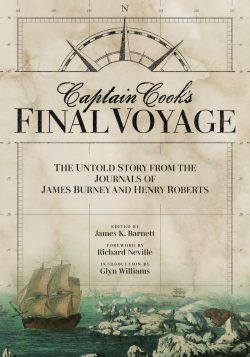 This handsome volume is a welcome addition to Cook historiography, particularly as it deals with the third voyage, long under-represented in the thousands of books that have been published about Cook and his voyages over the years. The author has edited and brought into print for the first time the journals of two young officers, James Burney and Henry Roberts — one on each of Cook’s last-voyage ships, along with a remarkably generous number of colour illustrations, both from the journals themselves — both men drew many maps of their stopovers during the voyage — and from the “final” paintings that John Webber developed, from earlier sketches and paintings, for the engravers to use to illustrate Cook’s own journal published in 1784. Both journal manuscripts and the Webber paintings are in the collections of the State Library of New South Wales in Sydney — the Burney ms in the Mitchell Library section, and the Roberts ms and Webber’s work in the Dixson Library section. While this book is not a standard narrative telling and interpretation of the third voyage story, and usually editions of journals are confined to public, university and museum libraries and the collections of Cook aficionados, there is enough here in Barnett’s introductions to different sections of the voyage and the superbly reproduced illustrations to merit interest from more general readers.
This handsome volume is a welcome addition to Cook historiography, particularly as it deals with the third voyage, long under-represented in the thousands of books that have been published about Cook and his voyages over the years. The author has edited and brought into print for the first time the journals of two young officers, James Burney and Henry Roberts — one on each of Cook’s last-voyage ships, along with a remarkably generous number of colour illustrations, both from the journals themselves — both men drew many maps of their stopovers during the voyage — and from the “final” paintings that John Webber developed, from earlier sketches and paintings, for the engravers to use to illustrate Cook’s own journal published in 1784. Both journal manuscripts and the Webber paintings are in the collections of the State Library of New South Wales in Sydney — the Burney ms in the Mitchell Library section, and the Roberts ms and Webber’s work in the Dixson Library section. While this book is not a standard narrative telling and interpretation of the third voyage story, and usually editions of journals are confined to public, university and museum libraries and the collections of Cook aficionados, there is enough here in Barnett’s introductions to different sections of the voyage and the superbly reproduced illustrations to merit interest from more general readers.
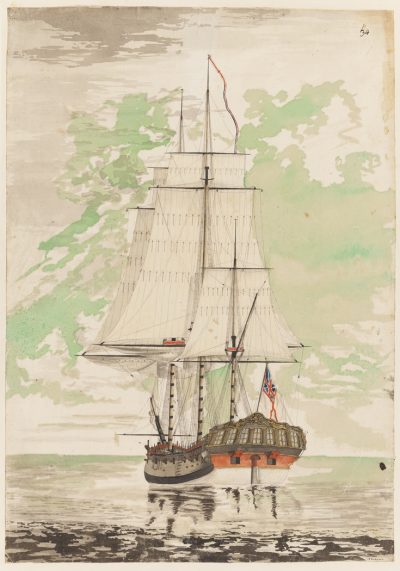
Of the two officers represented here by their journals, Burney was the older at 26 when the voyage began. He had already seen service in European waters before joining Cook on Resolution in 1772 for a short time before transferring to Adventure, Cook’s consort vessel for the Second Voyage, and receiving his commission as second lieutenant. Cook’s biographer, John Cawte Beaglehole has commented that although he never actually sailed very much with Cook himself — he was on Discovery with Charles Clerke for the Third Voyage and not on the Resolution until after Cook’s death — Burney emerges as one of the most interesting of Cook’s officers: a thorough seaman, lively, observant and articulate. Later he was to become a chronicler of the early exploration of the Pacific with a five-volume magnum opus published between 1803 and 1817. Henry Roberts, although still a teenager when the Third Voyage got underway in 1776, was also a veteran of the Second Voyage, having served on Resolution, where his skills as a cartographic artist were soon recognized. Again, on Resolution as Master’s Mate for the Third Voyage he worked closely with Cook and William Bligh on preparing the charts compiled on the expedition. At the end of the voyage, it was Roberts who was responsible for finalizing the charts to accompany the publication of Cook’s journal. Before his death in 1779, Cook also worked closely with Roberts on a world map with all the discoveries and routes of all three voyages; this famous chart was also published in 1784.
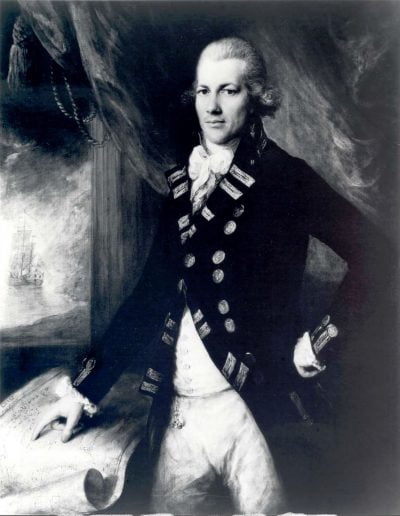
In addition to introducing his readers to Burney and Roberts, Barnett uses his Prologue to provide a history of the two journals and to discuss Webber and his paintings. He then divides the voyage and book into four parts — The South Seas, The Northwest Passage, Revisiting Hawai’i and the Death of Cook, and Homeward — each consisting of a detailed overview of that portion of the expedition, its progress and events, followed by subsections with another short comment and then the texts of the two journals. Thus, in Part Two — The Northwest Passage we find: Introduction, 1. Nootka Sound, 2. Prince William Sound and Cook Inlet, 3. Finding Arctic Ice, 4. Return to Unalaska. The journal texts in each section are interspersed with illustrations, but only in 2 & 4 in this instance are any of the journal charts reproduced. Although the two magnificent charts of Nootka Sound by Burney and Roberts are reproduced elsewhere (in the Prologue) it might have been more helpful to have them placed here with the journals’ coverage of the visit. Both show the location of “Ship Cove” where Resolution and Discovery anchored, and although Roberts’ chart is far superior technically, Burney’s is contextually more interesting with its bold identification of native “Towns” and the “Indian Town” — actually the Mowachaht village of Yuquot — which Cook visited on two occasions towards the end of the Nootka stay.
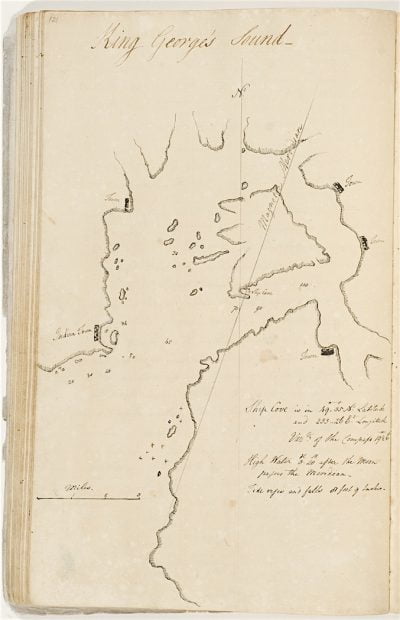
In an illuminating Introduction, the dean of Cook scholars today, Glyn Williams, notes that the great value of the journals of officers and others on the voyage is that one finds nuggets of difference between their comments and the official account penned by Cook. Cook, he reminds us, was aware that his account was not just for his superiors at the Admiralty, but also would be published for wider public audiences that in the countries of Europe, not just in Britain, were hungry for information about the exciting discoveries of new places and encounters with other cultures in distant and often exotic settings. In addition, Cook’s account reflected his personal priorities and his own views on “decisions made, negotiations undertaken and disputes settled.” Occasionally the captain’s “spin” was challenged by members of the expedition — sometimes seemingly universally as when Cook, stopping in New Zealand on the Third Voyage, “failed” to mete out retribution on the Maori who were identified as being responsible for the massacre of an entire landing party gathering “greens” at Grass Cove during the Second Voyage. Burney, who found the evidence of the massacre when sent on a reconnaissance by Tobias Furneaux, commander of Adventure, was particularly incensed. Likewise, when Cook left a trail of destruction when a goat was stolen in Moorea — destroying houses and canoes in a way comparable to how the Russians subdued the Unangax in the Aleutian Islands — there were many, including James King, John Williamson, and George Gilbert who questioned his judgement and humanity. Cook had his reasons which saw the goat as a symbol of one of his missions, bringing livestock to the South Seas as a gift of King George himself, and threats to his mission were always “red lines” to Cook as, in his dealings with natives and expedition members alike, he sought to navigate that lonely space occupied by all voyage commanders of the period — the line between just and unnecessary violence, and annoyance, even anger, and punishment; between naval regulations and practice, British values, and cross-cultural sensitivities. The point here is not so much what the other voices have to say, but the fact that they can be heard, to agree or disagree with the captain, to amplify and cover things not mentioned in the Cook’s official account, or indeed to ignore what he seems to have considered important. Thus Burney recalls being roughed up and taken prisoner for a short while in the Cook Islands, an incident unreported by Cook; while at Nootka James Trevenen reported that on small boat sorties, when Cook was away from “commanding” the Resolution, he seemed more relaxed and willing to engage in general conversation; and while both journals record the act of possession in Cook Inlet, neither do so for the previous event on Kayak Island (although both mention the landing) and only Roberts — likely because he was on Resolution, recorded the third “possession” on Cape Newenham.
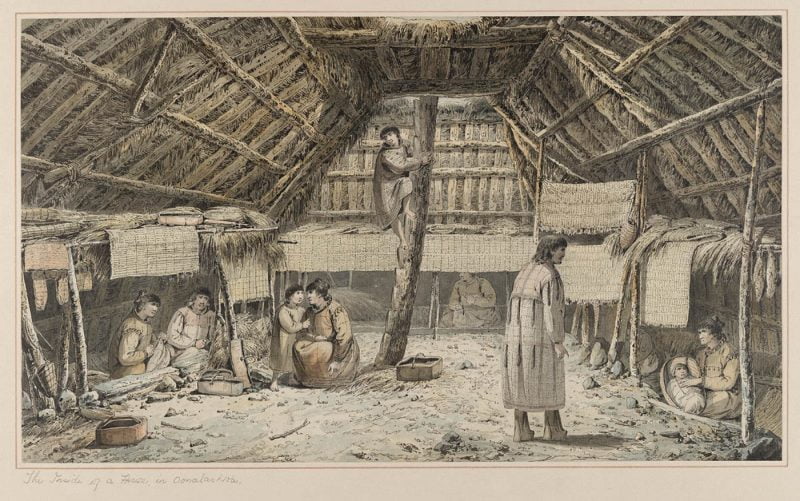
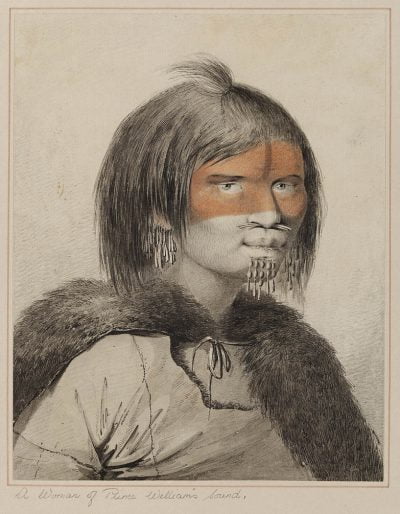
There is therefore immense value in a variety of voices being heard to provide “colour commentary” to Cook’s own views and version of events, and indeed to each other, and the publication of these two journals makes access to them so much easier of course than the logs still remaining in manuscript form such as those of Edward Riou or Thomas Edgar. In his short comments prefacing each section within the four parts into which the book is divided, Barnett provides useful notes to highlight what each journal says in the section to come, so in Sandwich [Prince William] Sound, Burney is seen to “struggle with the captain’s decision to abandon further exploration” — the author could have added that this might have been more appropriate at the head of “Cook’s River,” although by then the work done had persuaded Cook that this second channel offered no hope of a navigable passage — and Roberts “describes the narrow escape” off the rocks guarding Sedanka Island, near Unalaska, where Resolution got into serious trouble in heavy fog, a situation of near disaster that Cook himself recognized: “we had scaped very emminant danger…. Providence had conducted us through between these rocks where I should no have ventured in a clear day.” This quote and Charles Clerke’s ironic comment at the time on “very nice pilotage, considering our perfect Ignorance of our situation,” demonstrates the wealth of information that provides endless opportunities for cross-referencing the different voices on the voyage around a specific event or location. Space is always an issue and it may seem ungracious to ask for more, but the author seems content to let the journals speak for themselves in the context of comments in the various introductions and his generous endnotes that primarily reference helpful secondary works: however, some annotation in footnotes cross-referencing other contemporaneous views would have been a significant bonus.
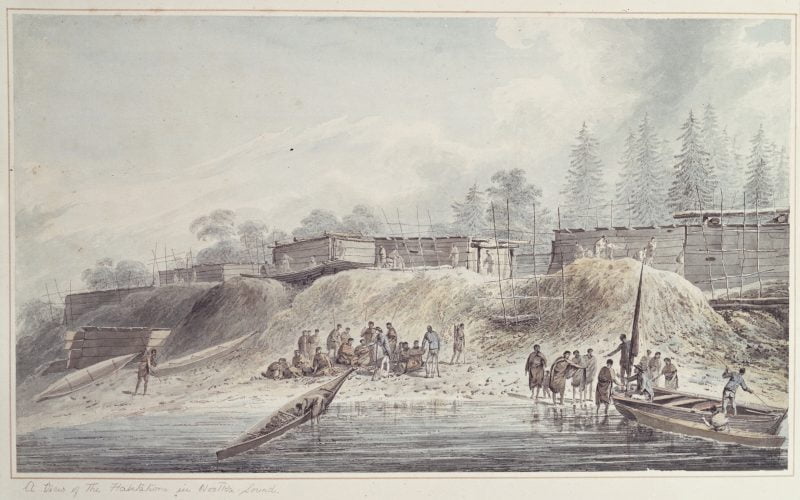
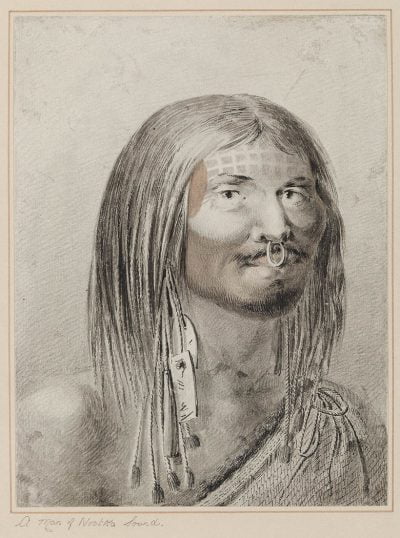
In general, we find Burney’s journal entries more extensive that those of his younger colleague, and he describes people and events at the stopover landings in more detail. At Nootka for example he has valuable commentary on the natives and their interactions with the visitors and he seems to have been on Discovery’s cutter when it accompanied Cook on his second visit to Yuquot. He doesn’t mention the Mowachaht’s keen sense of property that obliged Cook to pay for the grass he cut, but on the other hand he writes of the presence of cherry trees, gooseberry and current bushes, raspberries and strawberries, bemoaning the fact that — in April – “unluckily for us, none of them in season.” In Alaska, in Prince William Sound he comments on the Chugach natives, noting their use of lip ornaments and like Cook he was fascinated by the distinctiveness of their skin covered kayaks – “their Canoes are only slight wooden frames, covered with pieces of Whale Skin, neatly sewed together … which are for fishing, carry only one or two men and are close covered all round except where people sit, which is a round hole hooped. And to prevent any Water getting in, they wear jackets made of bladders, which tie close round their Necks and the bottom tucks under the Hoop. They paddle very fast….” In Unalaska, Burney essentially corroborates Cook’s much more extensive discussion of the Unganax natives and his meeting with the Russian fur trader Gerasim Izmailov. Like Cook, he found them a happy group, but mused as to the reasons: they were “kept under great Subjection by the Russians…. Whether it is owing to this their defenceless condition or to their natural disposition, they are the most quiet inoffensive set of Indians we have anywhere met with, and apparently as contented.”
Roberts, in contrast to Burney, has much more detail on the progress of navigating Resolution and of the everyday ups and downs of shipboard life. Thus, in the days approaching Nootka in March 1778, Burney is basically silent on the weather, whereas Roberts is more vociferous, noting almost daily “the weather very unsettled” with a combination of heavy swells, hard squalls, strong gales, hail, snow, sleet and rain. Compared to other commentators, he is less interested — although not entirely by any means — in the Mowachaht and, more in the interests of shipping, he writes about the abundance of good wood and the numerous “Harbours that this Inlet affords.” Likewise, in Cook Inlet, Roberts does not neglect the natives, but he spends a lot of time commenting on the difficulties of the navigation — wind, shoals and strong tides. Later the full value of his cartographic skills are on display in the exquisite chart he drew of Norton Sound.
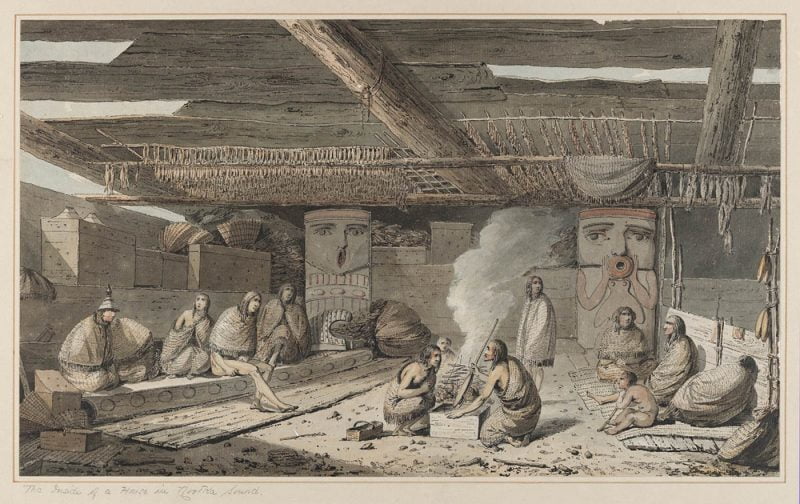
Both Burney and Roberts have interesting entries concerning the two most dramatic episodes of the voyage: encountering the Arctic icepack in 1778 and the visit to the big island of Hawai’i, especially the disastrous return to Kealakekua Bay in February 1779. However, in the first instance neither author is anything but matter of fact about the crushing disappointment of being stopped by the ice. There is no build-up of anticipation as the coast to starboard trended east such that James King on Resolution wrote of the men’s “high spirits” as they sailed towards the “ice free” Arctic and Hudson’s Bay. Rather Roberts, his colleague on the ship writes about “the Weather coming on Foggy” and “Sea Horses about the Ship” before he details the ice forming “a solid field, totally impossible for any Vessel to penetrate.” As the Resolution tacks back and forth along the ice edge, he notes three small boat sorties sent out to slaughter walruses with varying degrees of success, but he says nothing about Cook’s decision to suspend the salted rations in favour eating the fresh meat and the captain’s dubious assertion that “there were few on board who didn’t prefer” the experience. Neither, surprisingly, does he write about the Resolution getting into the critical situation of being driven by moving ice onto the rocky shore before ‘the Wind proved rather favourable’ (Cook’s words) and they escaped. For his part, Burney’s entry for the important date of August 17th when the ships hit the ice seems remarkably understated: “In the afternoon at 2 Saw a Field of Ice to the Northward. At half past 2 were close in with the Ice, on which were a great number of Sea Horses.” However, on August 20th he does make the point that before they headed west along the ice edge they had faced problems: “Having these 3 days past been pent up by a Shoal Coast on one side and Ice on the other, forming a deep Gulf, which by the drifting of the Ice has been continually growing narrower, and kept us under some apprehensions of being closed in.” A week later he provides a bit of gruesome colour around the sea horse hunt and expresses an opinion about the quality of the fare: “Our boats were out the greatest part of the day after Sea Horses, of which we caught 4. Cutting the throats of these and letting them bleed immediately as they were caught, so far cured them of their rank fishy taste, that they were by many thought preferable to the Ship Salt Meat.” The inclusion of Webber’s paintings of both the sea horse hunt and the Resolution and Discovery in peril in the days after they ran into the Arctic icepack help here to illustrate the journal texts. It is interesting that both journalists comment much more extensively about the dangers of navigating through fields of moving ice when the ships returned north in 1779.
En route north in 1778, our memorialists had commented on Cook’s landing in St Lawrence Bay on the east side of the Bering sea, where his technique of approaching strangers — in this case the Chukchi — alone and unarmed soon paid off when they “laid aside their Martial appearance and became sociable and friendly” (Burney): Roberts noted “The Inhabitants greeted them under Arms … but were presently reconciled to their new Visitors. The Party returned from the Shore, having purchased a few Curiosities from the Indians.” In his own account, Cook details this exchange: “for Knives, Beads, Tobacco &c some of their clothing and a few Arrows, but nothing we had to offer them would induce them to part with a Spear or a Bow, which they held in constant readiness … excepting one time, four or five laid them down while they gave us a Song and a Dance.” Barnett here reproduces Webber’s painting of two Chukchi men that clearly show their arms.
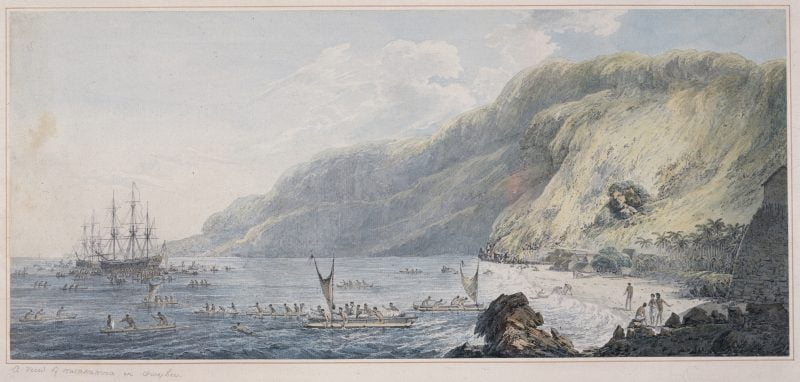

Like other accounts, Burney and Roberts provide important commentary about Kealakekua Bay in Hawai’I, both the initial visit and the return when Cook was killed. For both these sections Barnett prefaces the journal entries with extremely useful overviews. Of the two journals Burney’s is again more extensive and insightful. A good example is their different treatments of the welcome as the ships came into the bay and anchored. Roberts is content with a rather spare description: “In the Morning we were surrounded as Yesterday, the Canoes being full of Men. Women & Children. We had a baffling wind for some time off the Land, but soon after a breeze sprung up from the seaward, the boats ahead towing. A prodigious number of Canoes alongside with hundreds of Natives swimming off and the Shores crowded with Spectators.” Burney adds much more colour: “The Ships were accompanied into the Harbour by an immense Fleet of Canoes, near 800, according to those who took the pains to count. The people on board these, were not more numerous than those who having no Canoes swam off to us from the Shore as soon as we Anchored. The Numbers being too great to admit all Visitors, none but females were at first allowed entrance and with those the Ship soon became so thronged that many hundreds were obliged to be drove overboard to make room for carrying on the necessary duty of the Ship, and it was constant employment for a fourth part of the Ships Company to keep the decks clear.” No review can be expected to do justice to the journals’ coverage; suffice to say they both cover the events of the stopover, the ceremony that welcomed Cook, the native use of “tabu” that restricted spaces and the movement of people from time to time, the interactions with Chief “Terrioboo” and some similarities — language for example — as well as some divergences in the customs found elsewhere in Polynesia. Burney comments that, “The Natives are a stout active people, less cleanly in their Persons and I think more Savage in their appearance than the Natives of the Southern Islands.” Roberts is silent on such descriptions but true to his interest in the workings of the Resolution, he notes that men were given the lash for disobeying orders and one for “having connections with women knowing himself to be infused with the Venereal disorder….” Both men comment, however, on the volcanic nature of the topography and rocky countryside, noted as “several Expeditions or Rambles were made into the Country” (Burney). Because Cook’s own account breaks off after January 17th, 1779, over two weeks before the ships departed on February 4th and Canon John Douglas, the editor of the official 1784 publication, relied on the work of James King for the balance of the voyage’s story, the voices of the other contemporary authors such as Burney and Roberts take on greater significance. Cook’s memoir ceases at a moment of considerable importance before both the ceremony in which veneration towards him seemed akin to that accorded to a divine being, and his relationship with “Terrioboo” unfolded.
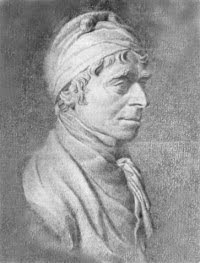
This importance of a diversity of voices to piece together a full understanding of the voyage is never more important than when we arrive at the ultimately tragic return to Kealakekua Bay caused when the recent repair to Resolution’s foremast didn’t hold in a sustained gale. This was a mere few days after the British had left. They were not welcomed. A practical reason for this was that Kealakekua Bay had been largely depleted of surplus food supplies as a result of the nearly three-week visit. The other reason was cultural; the initial visit had coincided with the festival of Makahiki and Cook had been welcomed as a representative of Lono, the god of peace, fertility and prosperity. This festival season had ended before they left, when Chief Kalani’opu’u (“Terreeobo”), whom the ships had met off Maui, returned home as the representative of Ku, the god of war. Antagonism characterized by open season on the theft of anything belonging to the visitors, soon shifted to actual hostility and attacks when the British responded. When Discovery’s cutter was stolen — a “red line” for Cook because such a threat compromised the working of the ships and therefore their mission — he resorted to a tried and true tactic. He would take Kalani’opu’u hostage until the cutter was returned. Entering a hostile part of the bay and finally faced by a gathering of “insolent” and “troublesome” supporters of the king, the plan had to be abandoned. When, during his retreat to the small boats, Cook was challenged and killed a man, the marines opened fire; the captain was engulfed by a wave of attackers and killed “with great violence.”
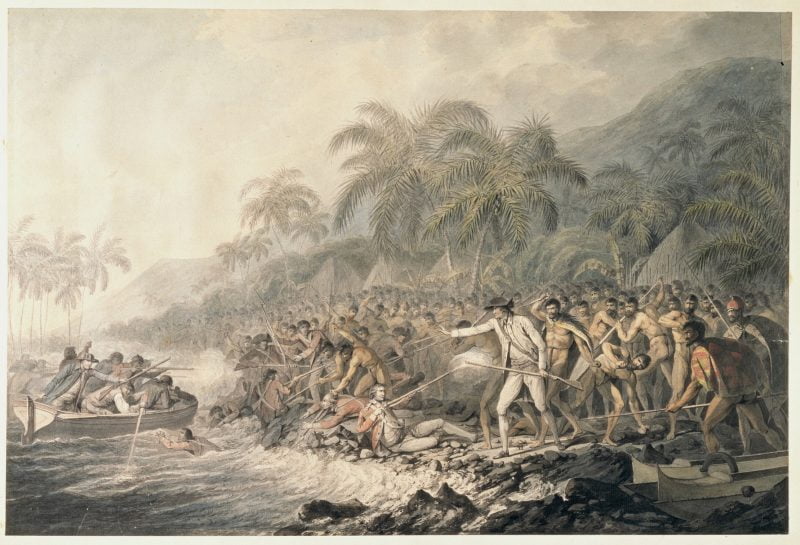

Both Roberts and Burney were eyewitnesses in different ways to the fracas on the beach. Roberts had commanded the pinnace that took Cook to the king’s village and so he was there. Burney watched through his telescope. Roberts’ account is very short but it has one telling sentence after he writes that Cook had opened fire with his small musket: “The Captain immediately gave orders to cease firing and come in with the boats.” After the event there were two interpretations of the disaster: one that Cook had precipitated the final assault by opening fire himself and ordering the marines to do so as well; the other that he was leaving as fast as possible, and had signalled the marines to cease firing and for the boats to come in. This latter view – “he was a victim of his own humanity” — prevailed in the official account, and was the subject of a large, influential painting by Webber, also in the collection of the State Library of New South Wales and reproduced here, engraved, published in later editions of Cook’s journal, and widely disseminated as a print.
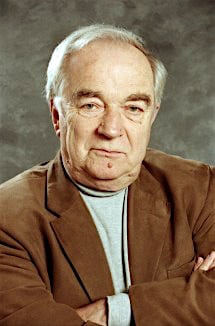
Burney’s extensive narrative covering the days of the return to Kealakekua Bay was developed from his own observations and from a number of interviews he engaged in — for example about a post-theft, dangerous and near tragic confrontation involving Thomas Edgar and George Vancouver, the day before Cook died. In a telling comment when writing about Cook’s view of any native resistance to Resolution’s cutter chasing a large canoe attempting to break a blockade of the bay to ensure the return of Discovery’s cutter, he notes: “he answered that there could be no great difficulty, for he was very positive the Indians would not stand the Fire of a single Muskett. Indeed, so many instances have occurred which have all helped to confirm this Opinion that it is not to be wondered at, if every body thought the same.” Clearly Cook took this view with him as he went to his death, but on the beach as Burney again says: “The Indians at first gave back [retreated] but directly after, before the Marines had time to load again, advanced.”
Barnett provides a wealth of reference information in his endnotes, and a short bibliography. In summary, the author’s efforts are to be applauded. So many books on Captain Cook and his voyages are repetitive and rehash the same interpretation with little new to offer. With its promise and invitation to understand new — previously essentially untold — perspectives, even if much is familiar, this publication of the Burney and Roberts journals is both worthwhile, valuable and welcome.
*
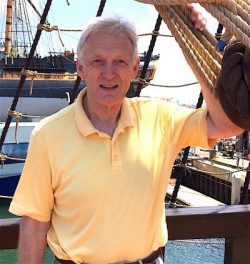
Robin Inglis is a former Director of the Vancouver Maritime Museum and the North Vancouver Museum and Archives. He is a Fellow of the Canadian Museums Association. After graduating from Cambridge University with a degree in history, he came to Canada to teach before taking a Master’s degree in Museum Studies at the University of Toronto. Since the 1980s he has studied, written and lectured on the early exploration of the Pacific coast of America, completing the Historical Dictionary of Discovery and Exploration of the Northwest Coast of America (Scarecrow Press) in 2008. He has curated major exhibitions on Pacific explorers Jean François Galaup de La Pérouse (1986), Alejandro Malaspina (1991), and James Cook (2015). Currently he is working with a colleague at the University of Victoria on a new translation and annotation of the 1789 Nootka journal of Esteban José Martínez; it will serve as a companion to the work he and other colleagues undertook to publish the 1792 journal of Juan Francisco de la Bodega y Quadra in 2012. Robin has received decorations in recognition of his work as a museum professional and historian from the governments of France, Spain, and Canada. He lives in Surrey, B.C.
*

The Ormsby Review. More Books. More Reviews. More Often.
Publisher and Editor: Richard Mackie
The Ormsby Review is a journal service for serious coverage of B.C. books and authors, hosted by Simon Fraser University. The Advisory Board consists of Jean Barman, Robin Fisher, Cole Harris, Wade Davis, Hugh Johnston, Patricia Roy, David Stouck, and Graeme Wynn. Scholarly Patron: SFU Graduate Liberal Studies. Honorary Patron: Yosef Wosk. Provincial Government Patron since September 2018: Creative BC
“Only connect.” – E.M. Forster